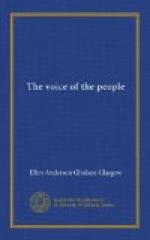A few years ago—so few that it is within the memory of the very young—the streets leading from the Capitol were the streets of a Southern town—bordered by hospitable Southern houses set in gardens where old-fashioned flowers bloomed. Now the gardens are gone and the houses are outgrown. Progress has passed, and in its wake there have sprung up obvious structures of red brick with brownstone trimmings. The young trees leading off into avenues of shade soften the harshness of an architecture which would become New York, and which belongs as much to Massachusetts as to Virginia.
The very girls who, on past summer afternoons, flitted in bareheaded loveliness from door to door, have changed with the changing times. The loveliness is perhaps more striking, less distinctive; with the flower-like heads have passed the old grace and the old dependence, and the undulatory walk has quickened into buoyant briskness. It is all modern—as modern as the red brick walls that are building where a quaint mansion has fallen.
But in the Capitol Square one forgets to-day and relives yesterday. Beneath the calm eyes of the warlike statue of the First American little children chase gray squirrels across the grass, and infant carriages with beruffled parasols are drawn in white and pink clusters beside the benches. Jefferson and Marshall, Henry and Nelson are secure in bronze when mere greatness has decayed.
To the left of the Capitol a gravelled drive leads between a short avenue of lindens to the turnstile iron gates that open before the governor’s house. Here, too, there is an atmosphere of the past and the picturesque. The lawn, dotted with chrysanthemums and rose trees, leads down from the rear of the house to a wall of grapevines that overlooks the street below. In front the yard is narrow and broken by a short circular walk, in the centre of which a thin fountain plays amid long-leaved plants. The house, grave, gray, and old-fashioned—the square side porches giving it a delusive suggestion of length—faces from its stone steps the thin fountain, the iron gates, beyond which stretches the white drive beneath the lindens, and the great bronze Washington above his bodyguard of patriots. Between the house and the city the square lies like a garden of green.
It was on a bright morning in January that Ben Galt entered one of the iron gateways of the square and walked rapidly across to the Capitol.
He ascended the steep flight of stone steps, and paused for an instant in the lobby which divided the Senate Chamber from the House of Delegates. The legislature had convened some six weeks before, and the building was humming like a vast beehive.
In the centre of the tesselated floor of the lobby, which was fitted out with rows of earthenware spittoons, stood Houdon’s statue of Washington, and upon the railing surrounding it groups of men were leaning as they talked. Occasionally a speaker would pause to send a mouthful of tobacco juice in aimless pursuit of a spittoon, or to slice off a fresh quid from the plug he carried in his pocket.




